(Words and photos by Red Line Synthetic Oil) – Race fans in the aging wooden grandstands at Auto Club Famoso Raceway in Bakersfield let out a collective breath as a pair of Nostalgia Top Fuel Dragsters materializes from the cloud of starting line tire smoke and flashes down the track to disappear in a puff of parachutes at the far end of the quarter-mile. The actual racing takes only a blink over five seconds. From the spectators’ viewpoint, a team’s race is won or lost in less time than it takes to spill a beer.
Whether they win or lose, for the drivers and crew of these 3,000-horsepower nitro burners, that five second run takes hours of prep time. I had the opportunity to hang out for the day with the Champion Speed Shop Nostalgia Top Fuel Dragster team out of Daly City, Calif. On the rare occasions when I wasn’t getting in the way of the carefully choreographed action, I was marveling at the incredible amount of work (and patience) that goes in to making it through a single day at the races.
The McClennan family-owned Champion Speed Shop has a history of drag racing which dates back to the 1950s but as the team prepares for the last qualifying round before eliminations, all that matters is the race to come. Here’s what it takes to run a day in a Nostalgia Top Fuel car.
7:30 a.m. – There are a few benefits to running in the upper ranks of racing. A sportsman racer in the Hot Rod or Gas classes might have an 8:00 a.m. call to the lanes. Since the nitro-burning cars are the big draw for the fans, the Top Fuelers are given a little more time to prepare, but that doesn’t mean they get to sleep in. Our host at the races, Champion Speed Shop driver Adam Sorokin, says a typical race day starts around 7 a.m. with a mandatory coffee stop for crew chief Bobby McLennan. What if there’s no Starbucks in the vicinity?
Sorokin looks up, straight-faced.
“We only race at tracks near a Starbucks,” he says.
8:30 a.m.– After the coffee run, the team heads to the track and by half past 8 they will have work benches out, canopies up and the race car rolled out of the hauler and ready for prep. Just setting up the pits is a job; running a nitro dragster requires a full mobile mechanics’ shop, with specialized tools, drums of oil, cases of parts cleaner, and multiple sets of tires, spark plugs, pistons and even engine blocks.
9:30 a.m.– Because nitromethane is a controlled substance, filling up a fuel car isn’t as easy as just stopping by the pump on the way to the track. Most teams buy fuel drums on site. Even though the Nostalgia Top Fuel class allows cars to run up to 100-percent nitro, many tuners prefer to run a mixture of nitro and alcohol, which means another fuel drum purchase. Most of the first morning at the track is spent wheeling 55-gallon drums around the pits.
10:00 a.m. – By mid-morning the team starts work on the car in earnest. Fuel jugs are filled and mixed, oil is parceled out in five-gallon jugs (the 377ci small-block Chevy in the Champion car—a rare engine combo for these cars–holds four gallons of 70WT Red Line synthetic racing oil at a time) and the car is stripped of its swoopy black and red bodywork and pushed out from under the awning for the first warm-up of the day.
10:30 a.m. – An engine warm-up in the pits has got to be one of the most popular attractions at theraces, second only to the racing itself, and for good reason. Burning nitro acts like teargas, and clouds of visible fumes swirl through the rows of car haulers as the driver dons a gas mask and mans the clutch and fuel lever while the car is put through its paces on the jack stands. Unburned fuel spits from the pipes every time the clutch is pressed and the crew members work inches away from the fumes and the fire.
During the warm-up, the team sets ignition timing and warms the rear end and motor oils. An engine “pull down” seats the clutch and shows how many RPMs the engine goes down when the clutch pedal is out. The goal is to predict what the car will do once it gets on the track, a tricky proposition when every change in weather and track surface can affect the final run.
11:00 a.m. – As soon as the car shuts off, crew member Jeff Stich turns the engine by hand to allow the hot exhaust valves to cool against the surface of the head and prevent warping. Crew members Joey Junta and Nick Sharp drain the fuel and oil—due to fuel dilution, the oil must be replaced every time the engine is run, and the ratio of nitro to alcohol that the crew chief wants to run also changes throughout the day, so a new mix goes in for every run.
Top fuel engines are under enormous stress, and with no other cooling system, the motor oil can literally make or break a run. Like most of the components on the car, the oil is specific to Top Fuel racing. McLennan runs a Red Line 70 weight synthetic racing oil in the Champion Speed Shop car, and the team can go through a 55-gallon drum in a weekend.
Before they button up the car to head to the staging lanes, the team replaces each of the spark plugs and measures the tire pressure and even the circumference of the tires themselves. Uneven tire height or “rollout” will make the car want to turn towards the smaller tire and turning is not a desired trait in a drag car. Nothing is taken for granted, which is why they pull out the tape measure as well as the tire pressure gauge.
11:20 a.m.– The flashy lettered body panels are DZUS fastened into place and given a final wipedown so the car sparkles as the tow vehicle rolls out the back of the pit lane and in to the staging area. Just towing a dragster is a challenge. The driver of the support truck has to remember that there’s a 225″ wheelbase dragster wriggling at the back of the tow line like a reluctant trout. Threading through the narrow lanes of fellow racers, golf carts and gawping spectators is a driving skill nearly on par with that of piloting the racecar on the track.
11:40 a.m. – At least the tow driver has air conditioning. For Sorokin, sitting fully suited in the dragster with the Bakersfield sun shining through the dragster’s enclosed cowling, the wait in the staging lanes can seem endless. He says he spends the time in the car visualizing the run to come.
“It’s my job to report back everything that happened on the run.” Sorokin says. “I need to be able to perform the job of driving almost through muscle memory, so that I can pay attention to the car rather than to the driving.”
12:10 p.m. – It’s finally go time. After the relatively quiet half hour spent sitting in the lanes, it’s like someone pressed fast forward on the remote. The track staging personnel point to the next pair up and all the teams in the lanes rush to do final checks on the drivers’ safety equipment as the cars roll towards the starting line.
Sorokin’s crew tows the car in to position, directly behind the waterbox in the assigned lane. The crew waits for the sign to fire the car, applies the external starter and then steps back as Adam rolls the car through the water and starts the burnout. A throttle stop is used to control rpm during the burnout, but everything after that is up to Sorokin, and it’s here that our story stops being measured in minutes and becomes instead about tenths of seconds.
“Top Fuel cars are a challenge to drive and will humble you pretty quickly if you err the least bit,” says Sorokin, and I see plenty of proof of that during the weekend as other drivers cross the center line, blow the start at the tree and blow up engines in the timing lights. Still, how much can the driver actually be doing in a sub six-second time frame?
As it turns out, quite a lot.
12:15 p.m. – As the car is fired, Sorokin turn on the fuel and adjusts the fuel pressure to approx. 60 psi for the burnout. Once McLennan adjusts the idle, he will nod to let Sorokin know that the car is ready to let the clutch out and move forward into the waterbox. During the burnout, Sorokin holds the throttle against the stop until just about even with the Christmas Tree. Once he sees the tree in peripheral vision, he closes the throttle, pulls the brake and pushes the clutch in.
Different drivers have different approaches to burnout length, based on both performance and showmanship, but Sorokin tries to stop the car around the 300ft cone. The carbon fiber brakes don’t work well while cold, which is why you’ll see many cars roll well past half-track before finally stopping.
Once the car is stopped, Sorokin checks the oil pressure and puts the car in reverse. The goal is to back up slowly in the same stripes of rubber which were just laid down during the burnout, all without using the clutch too many times to avoid building excessive heat or causing uncalculated wear.
Because Nostalgia Top Fuel drivers can see very little in front of the massive front-mounted engine (and nothing behind), crew members direct them back to the starting line with hand signals.
As the drivers prepare to stage, the crew wipes the tires to remove any pebbles, twigs or corndog wrappers which may have stuck to them after the burnout. It’s almost time to turn the car loose on the track.
Sorokin turns on the onboard oxygen tank which feeds through his helmet. Head mechanic Tony Bernardini, directs him to a few inches from the staging beams. At this point, McLennan and Bernardini may choose to increase the idle of the engine for the race by uncovering two holes on the injector hat.
Crewmember Dave Carkhuff then turns on the Racepak computer to record all the engine data for the run. Finally, Sorokin gets a sign from Bernardini. It’s now a driver’s game.
Sorokin lets the clutch out, holds the car back with the hand-operated brake lever and moves the car in to light the Pre-Stage bulb. Once both competitors are pre-staged, it’s time to fully stage. He shuts his visor, adjusts the fuel pressure to full and lets the clutch out.
You can hear the engine rpm change under the load as the drivers bump into the second staging beam.
When the amber lights flash, Sorokin hits the throttle and hangs on, looking for light grey concrete on either side of the blower to reassure him that he’s still in the middle of the lane.
During the run, a good driver pays attention to how the engine sounds and feels in order to be able to report back after the run what the car is doing at the hit of the throttle, at 300ft, at half track and all the way down the strip.
As soon as he knows he’s crossed the finish line, Sorokin pushes the parachute levers forward and covers the brake. He shuts off the fuel as the car slows down and looks for the turnout at the end of the track.
It’s still 12:15.
The run happens so fast you can barely see it over the shoulders of the photographers lining the wall. As soon as the crew sees the car clear the track, they pile in to the minivan and we dash up the return road to meet the car at the top end turn off.
12:16 p.m.– By the time we cover the 1,320 feet and reach him, Adam is already out of the car, rolling up the chutes and eager to know his ET and speed. He ran a respectable 5.78 @ 239.02mph. The team is pleased, but like all racers, they are already talking about how to go faster and more importantly, get a quicker ET for the afternoon’s first round of competition.
12:18 p.m.– As Adam reviews his time slip, crew member Jeff Stich again turns the engine by hand, which not only allows the exhaust valves to cool, but also clears the cylinders of any leftover nitromethane mix. It is, after all, a highly explosive substance. Once we are safe from nitro-related explosions, the car is reattached to its umbilical tow strap for the parade lap back past the stands and into the pits.
12:23 p.m. – There’s no lunch break or celebration over making it through qualifying. The first round of eliminations starts at 3 p.m., and the entire engine needs to be rebuilt and test started again before the call to lanes. The second the car stops rolling in the pit stall, the crew has the body off, the drain pans under the engine and fuel tank, and the spark plugs out and carefully labeled for Bernadini’s review. In the “big show” of NHRA Full Throttle Series Top Fuel racing, most engine parts are replaced after each round. Few nostalgia teams have that kind of budget, so out come the cans of parts cleaner. From piston rings to head gaskets, anything which can go another round is inspected, wiped down and reinstalled.
12:50 p.m. – Barely half an hour after the run, Sorokin’s team is already starting to reassemble the dragster’s engine.
1:19 p.m.– The engine, which was nothing more than a crankshaft in a block less than 20 minutes earlier, already has the blower back on top, the pushrods in, the heads on and the headers being bolted up.
1:50 p.m. – The team moves quietly around the car, each member of the team knowing what his job is and rarely even speaking to each other, even for two-person jobs like torqueing the wheels on the car. One crew member holds the brake as the other torques the lug nuts, and they seem to communicate through osmosis, always knowing where to be, even when one is completely out of sight beneath the 12″ slicks.
2:00 p.m. – Sandwiches. An army marches on its stomach, but there’s really no time during a race day for a sit-down meal. Crew members grab a bite during the few minutes when they aren’t needed on the car. During the whole day, I never once saw anyone sit for longer than five minutes. Even the driver and team owners are bustling about, refilling air tanks and signing autographs for fans.
2:14 p.m. – It’s a repeat of the morning as they roll the car back from the awning and prepare for the second test start of the day.
2:19 p.m. – The crowd gathers, drawn by the clouds of nitro and the crackle of the test-fire. Adam whacks the throttle and shuts it off and the crew moves on to the ritual of draining the warm-up oil and mixing up a new batch of fuel.
3:00 p.m. – The announcer calls the Top Fuel class to lanes for first round eliminations. Nothing changes in the procedure, there’s just the faintest hint of increased excitement in the staging lanes.
It’s a rough afternoon with numerous “oil downs” from engine failures on the runs ahead of us, as tuners push their cars to the limit in an attempt to beat their rivals. The repeated stops for track cleanup require the waiting drivers to get in and out of their cars and safety gear. It doesn’t seem to affect Sorokin’s focus though, and he and fellow racers banter cheerfully as they wait for the sign to suit back up.
4:15 p.m. – It’s a little after 4 by the time we finally pull the Champion Speed Shop car ( or as the announcers refer to it, “the Batmobile”) up to the line. Then there’s another delay for another cleanup. Racing, it’s mostly waiting.
4:27 p.m. – Thankfully, the track safety crew works quickly, and just before 4:30 Sorokin stages and runs. This is worth the wait. Sorokin is racing Terry Cox in the Cheetah IV Top Fuel dragster. Cox takes a gamble on the lights but it isn’t enough to win. The Batmobile lights the winner’s bulb with a 5.79 @ 229.55mph. It’s almost identical to the previous run and the team jokes that they should start running a bracket class as the minivan makes the drive to the far end to pick up the car.
“It’s good to get to race on Sunday,” says someone in the back of the van to general agreement.
As I leave the Champion Speed Shop pits, the crew is tearing the car down again. After examining the engine, they’ll roll the car in the hauler, close up the pits and head into town until the following day, when they’ll do it all over again.
Later, leaning against the spectator fencing and watching the vintage funny cars shoot fire in to the darkening sky, I think about the teams behind the stands in the pits, all working long hours for those elusive winning tenths of seconds.
Is it worth it, laboring nearly the equivalent of a full work week for barely 30 seconds of racing?
Since every single team is out there looking for an ever-lower ET, I’ll go out on a limb and guess that if they’ll work 40 hours for 30 seconds, they’d work even longer for less.



















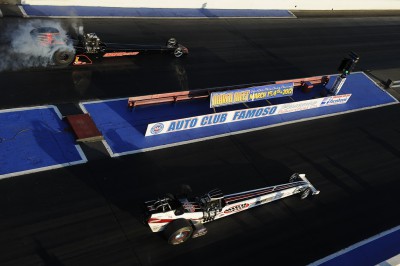
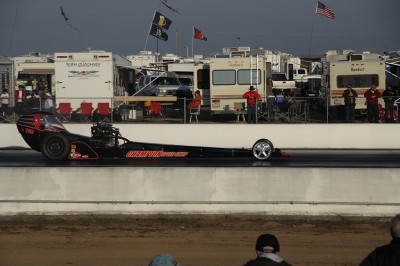
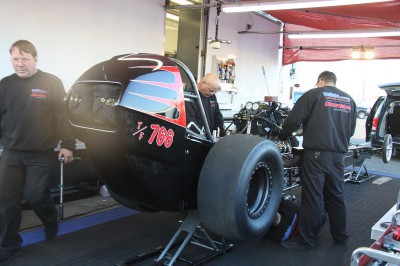



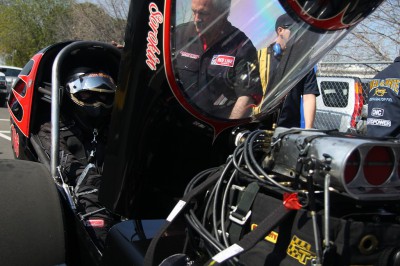
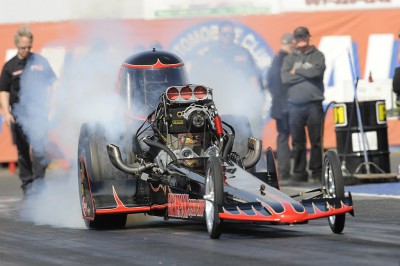

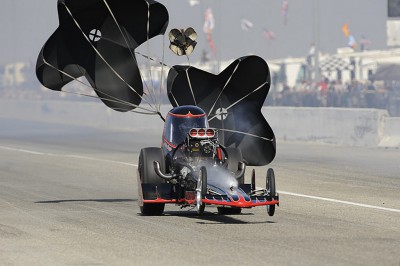
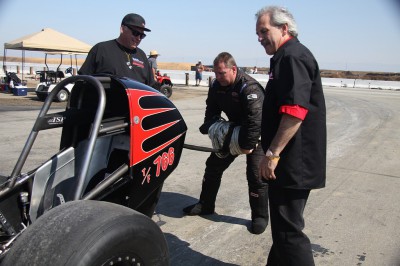











This has to be the quickest and fastest Chevy fueler of all time. No BBC has gone a 5.78. @ 238 and change. Can you imagine the fallout if this cars ever wins! All of Hemidom will scream bloody murder. Including Murray. No one has ever been able to perfect the tune on a BB to run on fuel. AJ could but, he’s busy. These CSS guys are way ahead of most fuel racers. They have this car so scienced out it’s scarry.
Adam is a great ambassador of front engine top fuel racing just like his dad Mike.
great article
Attractive component of content. I just stumbled upon your website and in accession capital to assert that I acquire actually enjoyed account your blog posts. Anyway I will be subscribing to your feeds and even I achievement you get entry to consistently rapidly.